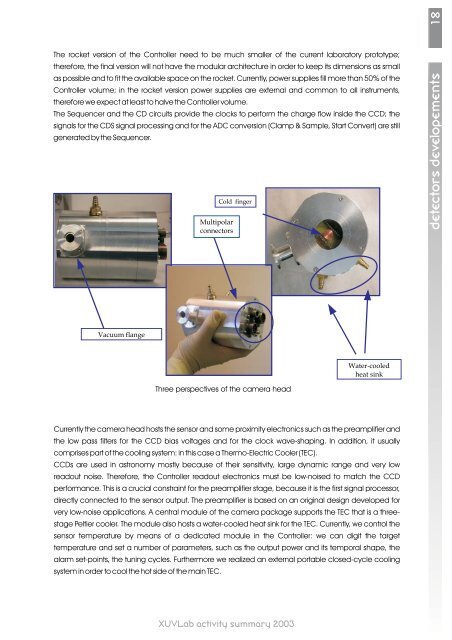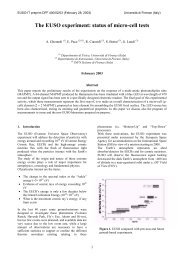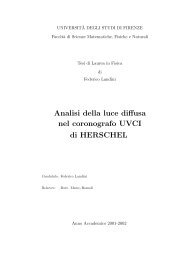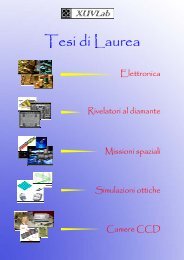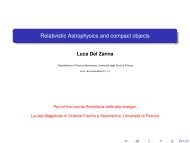2003 - Astronomia - Università degli Studi di Firenze
2003 - Astronomia - Università degli Studi di Firenze
2003 - Astronomia - Università degli Studi di Firenze
You also want an ePaper? Increase the reach of your titles
YUMPU automatically turns print PDFs into web optimized ePapers that Google loves.
The rocket version of the Controller need to be much smaller of the current laboratory prototype;<br />
therefore, the final version will not have the modular architecture in order to keep its <strong>di</strong>mensions as small<br />
as possible and to fit the available space on the rocket. Currently, power supplies fill more than 50% of the<br />
Controller volume; in the rocket version power supplies are external and common to all instruments,<br />
therefore we expect at least to halve the Controller volume.<br />
The Sequencer and the CD circuits provide the clocks to perform the charge flow inside the CCD; the<br />
signals for the CDS signal processing and for the ADC conversion (Clamp & Sample, Start Convert) are still<br />
generated by the Sequencer.<br />
Vacuum flange<br />
Multipolar<br />
connectors<br />
Cold finger<br />
Three perspectives of the camera head<br />
XUVLab activity summary <strong>2003</strong><br />
Water-cooled<br />
heat sink<br />
Currently the camera head hosts the sensor and some proximity electronics such as the preamplifier and<br />
the low pass filters for the CCD bias voltages and for the clock wave-shaping. In ad<strong>di</strong>tion, it usually<br />
comprises part of the cooling system: in this case a Thermo-Electric Cooler (TEC).<br />
CCDs are used in astronomy mostly because of their sensitivity, large dynamic range and very low<br />
readout noise. Therefore, the Controller readout electronics must be low-noised to match the CCD<br />
performance. This is a crucial constraint for the preamplifier stage, because it is the first signal processor,<br />
<strong>di</strong>rectly connected to the sensor output. The preamplifier is based on an original design developed for<br />
very low-noise applications. A central module of the camera package supports the TEC that is a threestage<br />
Peltier cooler. The module also hosts a water-cooled heat sink for the TEC. Currently, we control the<br />
sensor temperature by means of a de<strong>di</strong>cated module in the Controller: we can <strong>di</strong>git the target<br />
temperature and set a number of parameters, such as the output power and its temporal shape, the<br />
alarm set-points, the tuning cycles.<br />
Furthermore we realized an external portable closed-cycle cooling<br />
system in order to cool the hot side of the main TEC.<br />
detectors developements 18


